operating your vehicle SUZUKI BALENO 1999 1.G Owners Manual
[x] Cancel search | Manufacturer: SUZUKI, Model Year: 1999, Model line: BALENO, Model: SUZUKI BALENO 1999 1.GPages: 65, PDF Size: 3.28 MB
Page 1 of 65
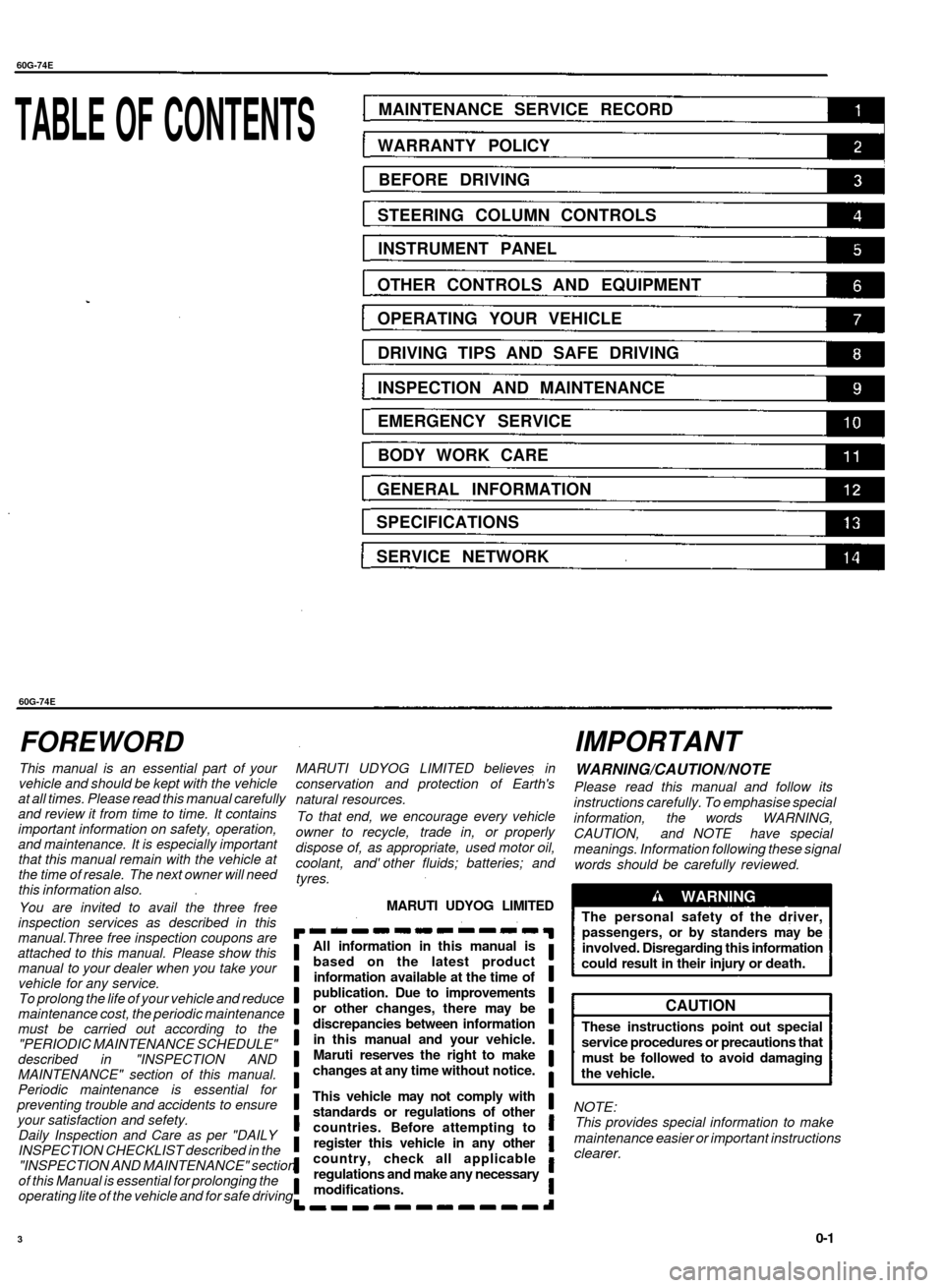
60G-74E
TABLE OF CONTENTS
MAINTENANCE SERVICE RECORD
WARRANTY POLICY
BEFORE DRIVING
STEERING COLUMN CONTROLS
INSTRUMENT PANEL
OTHER CONTROLS AND EQUIPMENT
OPERATING YOUR VEHICLE
DRIVING TIPS AND SAFE DRIVING
INSPECTION AND MAINTENANCE
EMERGENCY SERVICE
BODY WORK CARE
GENERAL INFORMATION
SPECIFICATIONS
SERVICE NETWORK
60G-74E
FOREWORD
This manual is an essential part of your
vehicle and should be kept with the vehicle
at all times. Please read this manual carefully
and review it from time to time. It contains
important information on safety, operation,
and maintenance. It is especially important
that this manual remain with the vehicle at
the time of resale. The next owner will need
this information also.
You are invited to avail the three free
inspection services as described in this
manual.Three free inspection coupons are
attached to this manual. Please show this
manual to your dealer when you take your
vehicle for any service.
To prolong the life of your vehicle and reduce
maintenance cost, the periodic maintenance
must be carried out according to the
"PERIODIC MAINTENANCE SCHEDULE"
described in "INSPECTION AND
MAINTENANCE" section of this manual.
Periodic maintenance is essential for
preventing trouble and accidents to ensure
your satisfaction and sefety.
Daily Inspection and Care as per "DAILY
INSPECTION CHECKLIST described in the
"INSPECTION AND MAINTENANCE" section
of this Manual is essential for prolonging the
operating lite of the vehicle and for safe driving.
MARUTI UDYOG LIMITED believes in
conservation and protection of Earth's
natural resources.
To that end, we encourage every vehicle
owner to recycle, trade in, or properly
dispose of, as appropriate, used motor oil,
coolant, and' other fluids; batteries; and
tyres.
MARUTI UDYOG LIMITED
All information in this manual is
based on the latest product
information available at the time of
publication. Due to improvements
or other changes, there may be
discrepancies between information
in this manual and your vehicle.
Maruti reserves the right to make
changes at any time without notice.
This vehicle may not comply with
standards or regulations of other
countries. Before attempting to
register this vehicle in any other
country, check all applicable
regulations and make any necessary
modifications.
IMPORTANT
WARNING/CAUTION/NOTE
Please read this manual and follow its
instructions carefully. To emphasise special
information, the words WARNING,
CAUTION, and NOTE have special
meanings. Information following these signal
words should be carefully reviewed.
WARNING
The personal safety of the driver,
passengers, or by standers may be
involved. Disregarding this information
could result in their injury or death.
CAUTION
These instructions point out special
service procedures or precautions that
must be followed to avoid damaging
the vehicle.
NOTE:
This provides special information to make
maintenance easier or important instructions
clearer.
0-1
3
Page 2 of 65
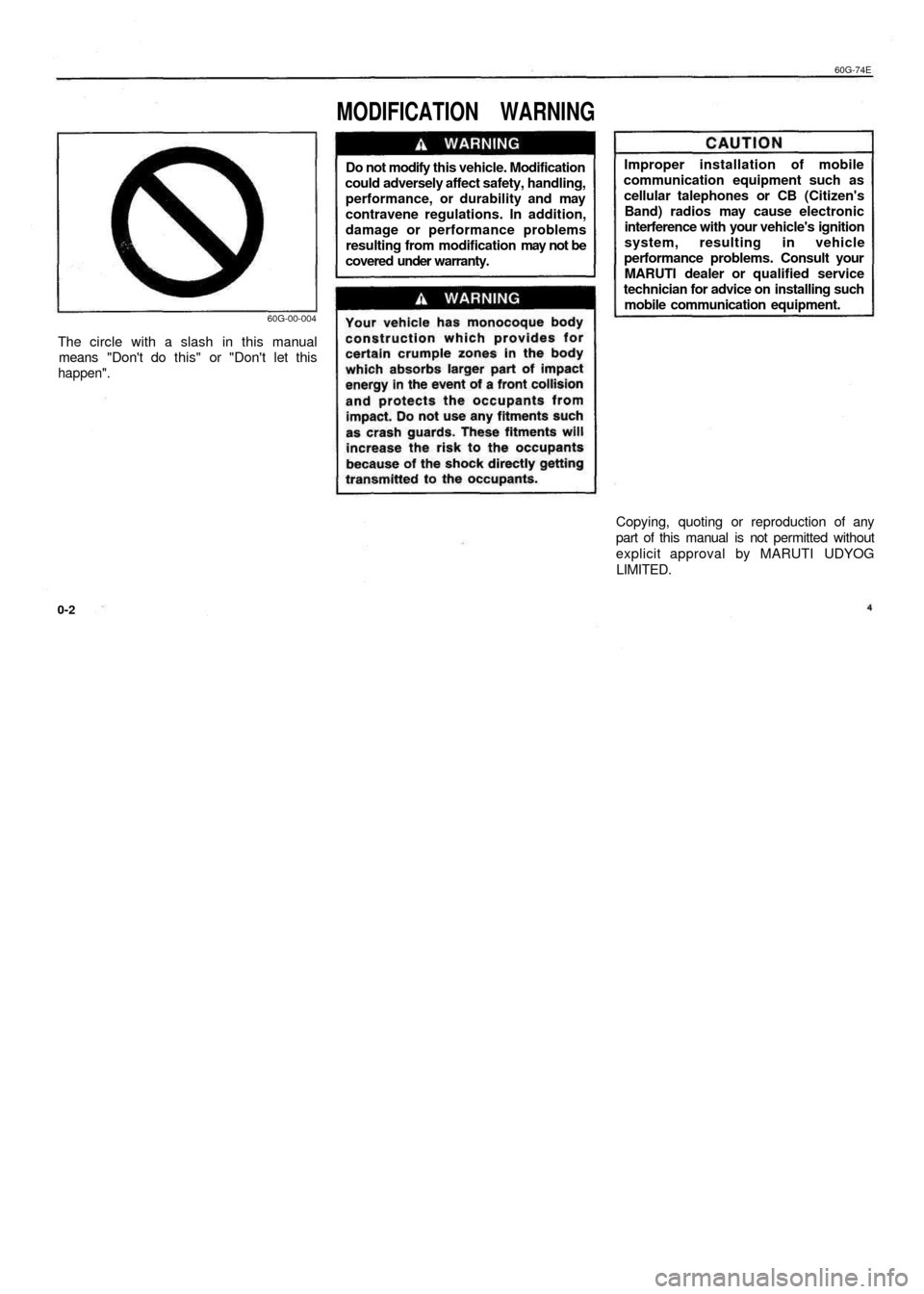
60G-74E
MODIFICATION WARNING
60G-00-004
The circle with a slash in this manual
means "Don't do this" or "Don't let this
happen".
Do not modify this vehicle. Modification
could adversely affect safety, handling,
performance, or durability and may
contravene regulations. In addition,
damage or performance problems
resulting from modification may not be
covered under warranty.
Improper installation of mobile
communication equipment such as
cellular talephones or CB (Citizen's
Band) radios may cause electronic
interference with your vehicle's ignition
system, resulting in vehicle
performance problems. Consult your
MARUTI dealer or qualified service
technician for advice on installing such
mobile communication equipment.
0-2
Copying, quoting or reproduction of any
part of this manual is not permitted without
explicit approval by MARUTI UDYOG
LIMITED.
60G-74E
WARRANTY POLICY
WARRANTY POLICY
Maruti Udyog Limited (hereinafter called "Maruti"), warrants that each
new Maruti vehicle distributed in India by Maruti and sold by an
authorised Maruti dealer will be free, under normal use and service,
from any defects in material and workmanship at the time of
manufacture SUBJECT TO THE FOLLOWING TERMS AND
CONDITIONS:
(1) Qualification:
To qualify for this warranty:
(a) The Maruti vehicle must be delivered by Maruti authorised
dealer and set-up, serviced by Maruti authorised dealer/
service station.
(b) The warranty registration card in respect of each vehicle
must be completed by the dealer at the time of delivery
of the vehicle and dealer should retain the same.
(2) Term:
The term of the warranty shall be twenty four (24) months
or 40,000 kilometers (whichever occurs first) from the date
of delivery to the first owner.
(3) Maruti's Warranty Obligation:
If any defect(s) should be found in a Maruti vehicle within the
term stipulated above, Maruti's only obligation is to repair or
replace at its sole discretion any part shown to be defective,
with a new part or the equivalent at no cost to the owner for
parts or labour, when Maruti acknowledges that such a defect
is attributable to faulty material or workmanship at the time of
manufacture. The owner is responsible of any repair or
replacements which are not covered by this warranty.
(4) Limitation:
This warranty shall not apply to:
(a) normal maintenance service required other than the three
free services, including without limitation, oil and fluid
changes, headlight aiming, fastener retightening, wheel
balancing, wheelalignment and tyre rotation, cleaning of
injectors, adjustments of carburettor, ignition timing, clutch
and valve clearance.
(b) the replacement of normal wear parts including without
limitation, bulbs, battery, tyres and tubes, spark plugs, belts,
hoses, filters, wiper blades, brushes, contact points, fuses,
clutch disc, brake shoes, brake pads, cable and all rubber
parts (except oil seal and glass run).
(c) any vehicle which has been used for competition or racing.
(d) any repairs or replacement required as a result of accidents
or collision.
(e) any defects caused by misuse, negligence, abnormal use or
insufficient care.
(f) any vehicle which has been modified or altered, including
without limitation, the installation of performance accessories.
(g) any vehicle on which parts or accessories not approved by
Maruti have been used.
(h) any vehicle which has not been operated in accordance with
the operating instructions in the Maruti Owner's Manual,
(i) any vehicle which has not received, during the warranty
term, the service inspections prescribed in the Maruti
Owner's Manual.
G) any vehicle which has been assembled, disassembled,
adjusted or repaired by other than an Maruti authorised
2-1
Page 3 of 65
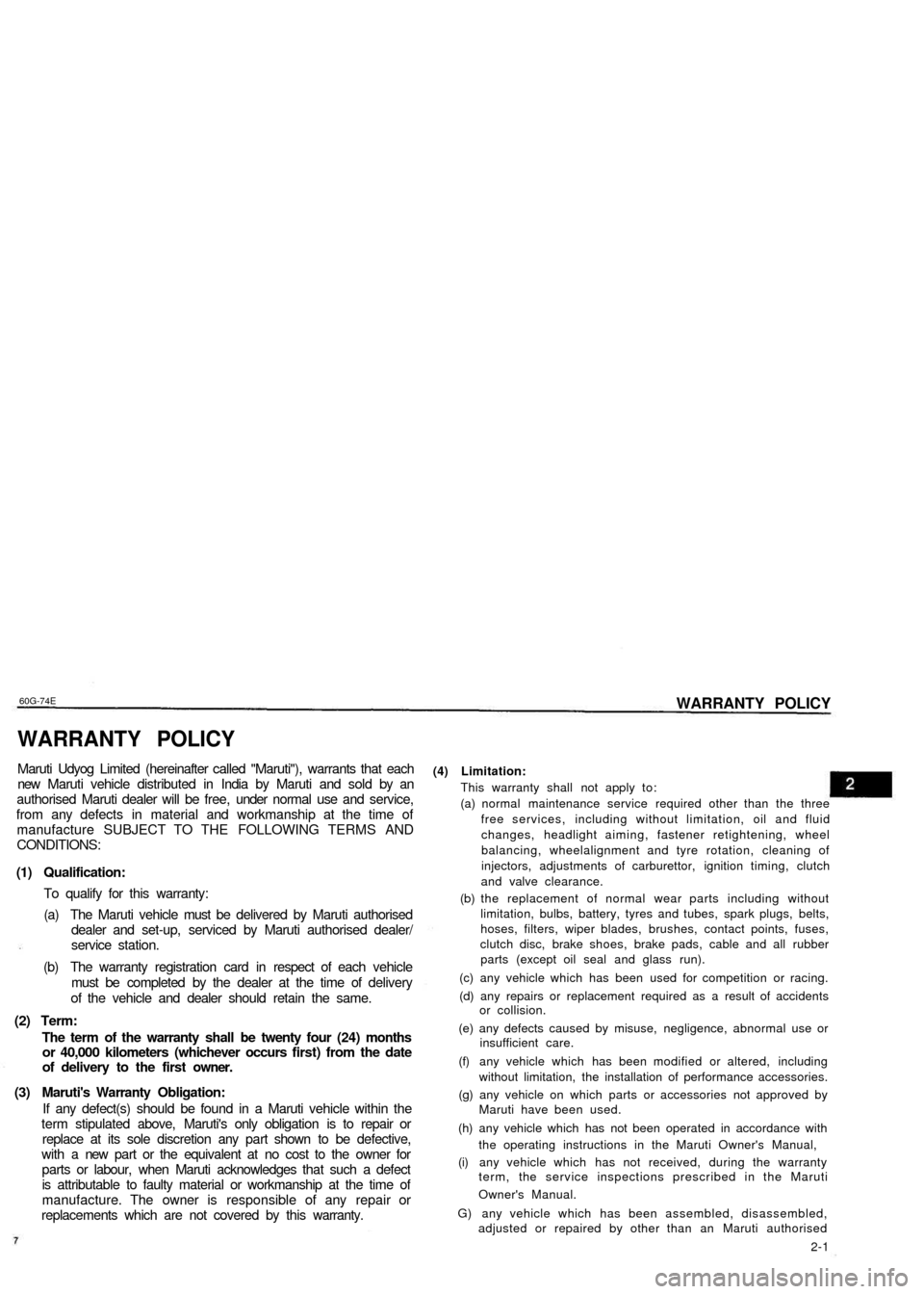
60G-74E
MODIFICATION WARNING
60G-00-004
The circle with a slash in this manual
means "Don't do this" or "Don't let this
happen".
Do not modify this vehicle. Modification
could adversely affect safety, handling,
performance, or durability and may
contravene regulations. In addition,
damage or performance problems
resulting from modification may not be
covered under warranty.
Improper installation of mobile
communication equipment such as
cellular talephones or CB (Citizen's
Band) radios may cause electronic
interference with your vehicle's ignition
system, resulting in vehicle
performance problems. Consult your
MARUTI dealer or qualified service
technician for advice on installing such
mobile communication equipment.
0-2
Copying, quoting or reproduction of any
part of this manual is not permitted without
explicit approval by MARUTI UDYOG
LIMITED.
60G-74E
WARRANTY POLICY
WARRANTY POLICY
Maruti Udyog Limited (hereinafter called "Maruti"), warrants that each
new Maruti vehicle distributed in India by Maruti and sold by an
authorised Maruti dealer will be free, under normal use and service,
from any defects in material and workmanship at the time of
manufacture SUBJECT TO THE FOLLOWING TERMS AND
CONDITIONS:
(1) Qualification:
To qualify for this warranty:
(a) The Maruti vehicle must be delivered by Maruti authorised
dealer and set-up, serviced by Maruti authorised dealer/
service station.
(b) The warranty registration card in respect of each vehicle
must be completed by the dealer at the time of delivery
of the vehicle and dealer should retain the same.
(2) Term:
The term of the warranty shall be twenty four (24) months
or 40,000 kilometers (whichever occurs first) from the date
of delivery to the first owner.
(3) Maruti's Warranty Obligation:
If any defect(s) should be found in a Maruti vehicle within the
term stipulated above, Maruti's only obligation is to repair or
replace at its sole discretion any part shown to be defective,
with a new part or the equivalent at no cost to the owner for
parts or labour, when Maruti acknowledges that such a defect
is attributable to faulty material or workmanship at the time of
manufacture. The owner is responsible of any repair or
replacements which are not covered by this warranty.
(4) Limitation:
This warranty shall not apply to:
(a) normal maintenance service required other than the three
free services, including without limitation, oil and fluid
changes, headlight aiming, fastener retightening, wheel
balancing, wheelalignment and tyre rotation, cleaning of
injectors, adjustments of carburettor, ignition timing, clutch
and valve clearance.
(b) the replacement of normal wear parts including without
limitation, bulbs, battery, tyres and tubes, spark plugs, belts,
hoses, filters, wiper blades, brushes, contact points, fuses,
clutch disc, brake shoes, brake pads, cable and all rubber
parts (except oil seal and glass run).
(c) any vehicle which has been used for competition or racing.
(d) any repairs or replacement required as a result of accidents
or collision.
(e) any defects caused by misuse, negligence, abnormal use or
insufficient care.
(f) any vehicle which has been modified or altered, including
without limitation, the installation of performance accessories.
(g) any vehicle on which parts or accessories not approved by
Maruti have been used.
(h) any vehicle which has not been operated in accordance with
the operating instructions in the Maruti Owner's Manual,
(i) any vehicle which has not received, during the warranty
term, the service inspections prescribed in the Maruti
Owner's Manual.
G) any vehicle which has been assembled, disassembled,
adjusted or repaired by other than an Maruti authorised
2-1
Page 13 of 65
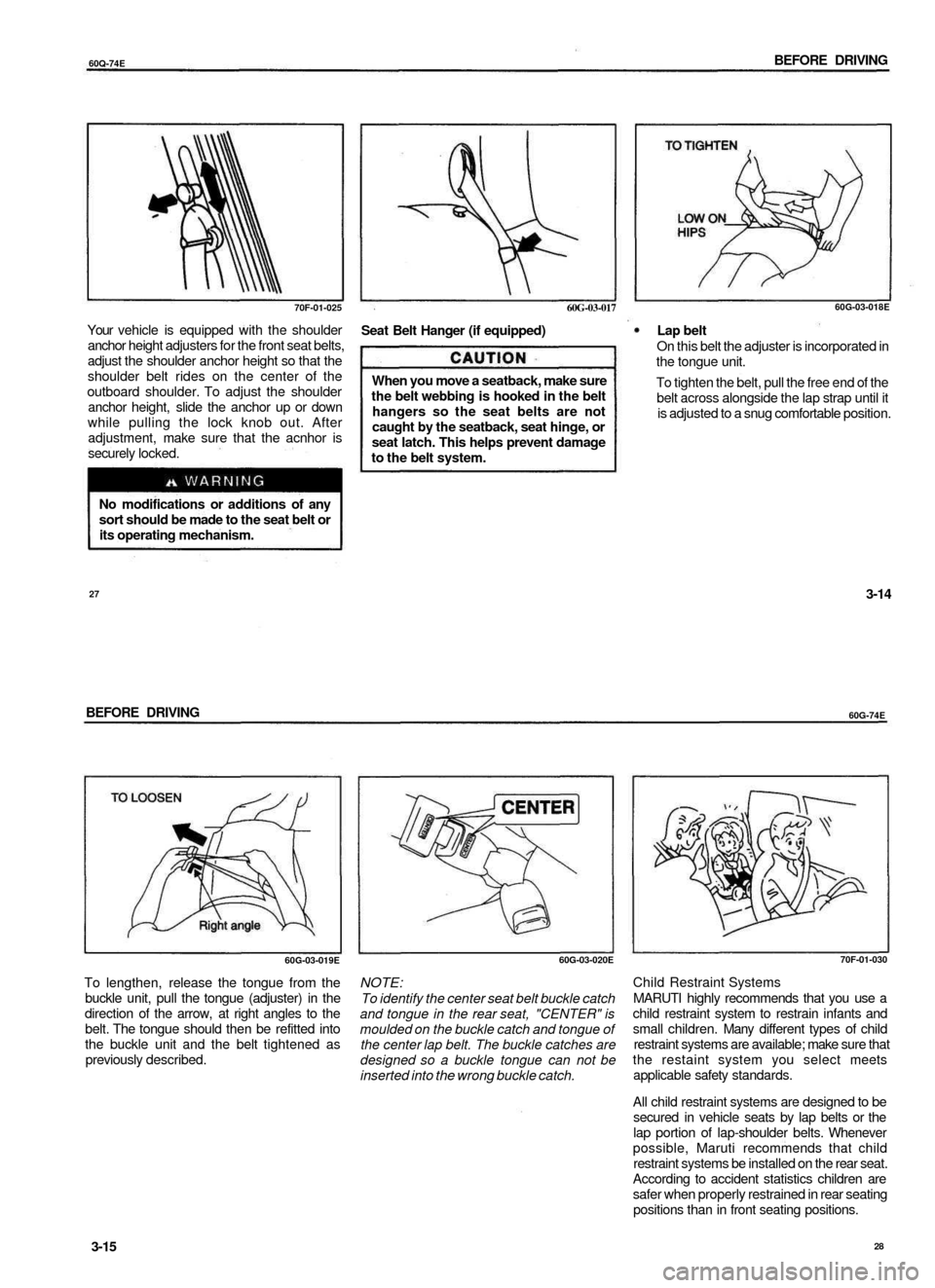
60Q-74E
BEFORE DRIVING
70F-01-025
Your vehicle is equipped with the shoulder
anchor height adjusters for the front seat belts,
adjust the shoulder anchor height so that the
shoulder belt rides on the center of the
outboard shoulder. To adjust the shoulder
anchor height, slide the anchor up or down
while pulling the lock knob out. After
adjustment, make sure that the acnhor is
securely locked.
No modifications or additions of any
sort should be made to the seat belt or
its operating mechanism.
60G-03-017
Seat Belt Hanger (if equipped)
When you move a seatback, make sure
the belt webbing is hooked in the belt
hangers so the seat belts are not
caught by the seatback, seat hinge, or
seat latch. This helps prevent damage
to the belt system.
60G-03-018E
Lap belt
On this belt the adjuster is incorporated in
the tongue unit.
To tighten the belt, pull the free end of the
belt across alongside the lap strap until it
is adjusted to a snug comfortable position.
27
3-14
BEFORE DRIVING
60G-74E
60G-03-019E
To lengthen, release the tongue from the
buckle unit, pull the tongue (adjuster) in the
direction of the arrow, at right angles to the
belt. The tongue should then be refitted into
the buckle unit and the belt tightened as
previously described.
60G-03-020E
NOTE:
To identify the center seat belt buckle catch
and tongue in the rear seat, "CENTER" is
moulded on the buckle catch and tongue of
the center lap belt. The buckle catches are
designed so a buckle tongue can not be
inserted into the wrong buckle catch.
70F-01-030
Child Restraint Systems
MARUTI highly recommends that you use a
child restraint system to restrain infants and
small children. Many different types of child
restraint systems are available; make sure that
the restaint system you select meets
applicable safety standards.
All child restraint systems are designed to be
secured in vehicle seats by lap belts or the
lap portion of lap-shoulder belts. Whenever
possible, Maruti recommends that child
restraint systems be installed on the rear seat.
According to accident statistics children are
safer when properly restrained in rear seating
positions than in front seating positions.
3-15
28
Page 16 of 65

6OG-74E
STEERING COLUMN CONTROLS
ACC
Accessories such as the radio can operate,
but the engine is off.
ON
This is the normal operating position. All
electrical systems are on.
START
This is the position for starting the engine using
the starter motor. The key should be released
from this position as soon as the engine starts.
Never remove the ignition key while
the vehicle is moving. The steering
wheel will lock and you will not be
able to steer the vehicle.
Do not leave children alone In a
parked vehicle. Unattended children
could cause accidental movement of
the vehicle, which could result in
severe personal Injury.
Always remove the key when parked
to prevent unintentional operation of
the vehicle and to improve security.
LIGHTING/TURN SIGNAL
CONTROL LEVER
CAUTION
Do not use the starter motor for
more than 15 seconds at a time. If
the engine does not start; wait 15
seconds before trying again. If the
engine does not start after several
attempts, check the fuel and ignition
systems or consult your MARUTI
dealer.
Do not leave the ignition switch in
the "ON" position if the engine is not
running as the battery will
discharge.
60G-04-003
This control lever is located on the outboard
side of the steering column. Operate the lever
as described below.
Lighting Operation
To turn the lights on or off, twist the knob on
the end of the lever. There are three positions:
in the "OFF" position all lights are off; in the
middle position the front parking lights, tail-
lights, registration plate light, and instrument
lights are on, but the headlights are off; in the
third position the headlights come on in
addition to the other lights.
33
4-2
STEERING COLUMN CONTROLS
60G-74E
With the headlights on, push the lever forward
to switch to the high beams (main beams) or
pull the lever toward you to switch to the low
beams. When the high beams (main beams)
are on, a light on the instrument panel will
come on. To flash the high beams (main
beams) pull the lever slightly towards you and
release it.
Lights "On" Reminder (if Equipped)
A buzzer/chime sounds to remind you to turn
off the lights if they are left on when the ignition
key is removed and the driver's door is opened.
Turn Signal Operation
With the ignition switch in the "ON" position,
move the lever up or down to activate the left
or right turn signals.
Normal Turn Signal
Move the lever clockwise until it clicks to signal
a right turn or anticlockwise to signal a left
turn. When the turn is completed, the signal
will cancel and the lever will return to its normal
position.
6OG-04-006
Lane Change Signal
Some times, such as when changing lanes,
the steering wheel is not turned far enough
to cancel the turn signal. For convenience,
you can flash the turn signal by moving the
lever part way and holding it there. The
lever will return to its normal position when
you release it.
4-3
34
60G-04-006
60G-04-005
60G-04-004E
Page 17 of 65

60G-74E
STEERING COLUMN CONTROLS
WINDSCREEN WIPER AND
WASHER LEVER
60G-04-007E
Windscreen Wipers
To turn the windscreen wipers on, move the
lever down to one of the three operating
positions. In the "INT position (if equipped),
the wipers operate intermittently. The "INT'
position is very convenient for driving in mist
or light rain. In the "LO" position, the wipers
operate at a steady low speed. In the "HI"
position, the wipers operate at a steady high
speed. To turn off the wipers, move the lever
back to the "OFF position.
60G-04-008E
If the lever is equipped with "INT TIME" control,
turn the control toward the "SLOW" or "FAST'
positions to adjust the intermittent wiper
operation to the desired interval.
60G-04-011E
The operation of windscreen wiper and washer
Type-2 is same as Type-1.
60G-04-009E
Windscreen Washer
To spray windscreen washer fluid, pull the
lever toward you. The windscreen wipers will
automatically turn on at low speed if
they are not already on and the "INT" position
is equipped.
To prevent windscreen icing in cold
weather, turn on the defroster to heat
the windscreen before and during
windscreen washer use.
Do not use radiator antifreeze in the
windscreen washer reservoir. It can
severely impair visibility when
sprayed on the windscreen, and can
also damage your vehicle's paint.
35
4-4
STEERING COLUMN CONTROLS
60G-74E
CAUTION
To help prevent damage to the
windscreen wiper and washer system
components, you should take the
following precautions:
• Do not continue to hold in the lever
when there is no windscreen washer
fluid being sprayed or the washer
motor can be damaged.
• Do not attempt to remove dirt from
a dry windscreen with the wipers or
you can damage the windscreen and
the wiper blades. Always wet the
windscreen with washer fluid before
operating the wipers.
• Clear ice or packed snow from the
wiper blades before using the
wipers.
• Check the washer fluid level
regularly. Check it often when the
weather is bad.
• Only fill the washer fluid reservoir
3/4 full during cold weather to allow
room for expansion if the
temperature falls low enough to
freeze the solution.
HORN
REAR WIPER AND WASHER
(if equipped)
60G-04-010
Press the horn button of the steering wheel to
sound the horn. The horn will sound with the
ignition switch in any position.
Press the button located at the end of the
windscreen wiper and washer lever to operate
the rear washer and turn the lever anti
clockwise to operate the rear washer.
4-5
36
Page 24 of 65
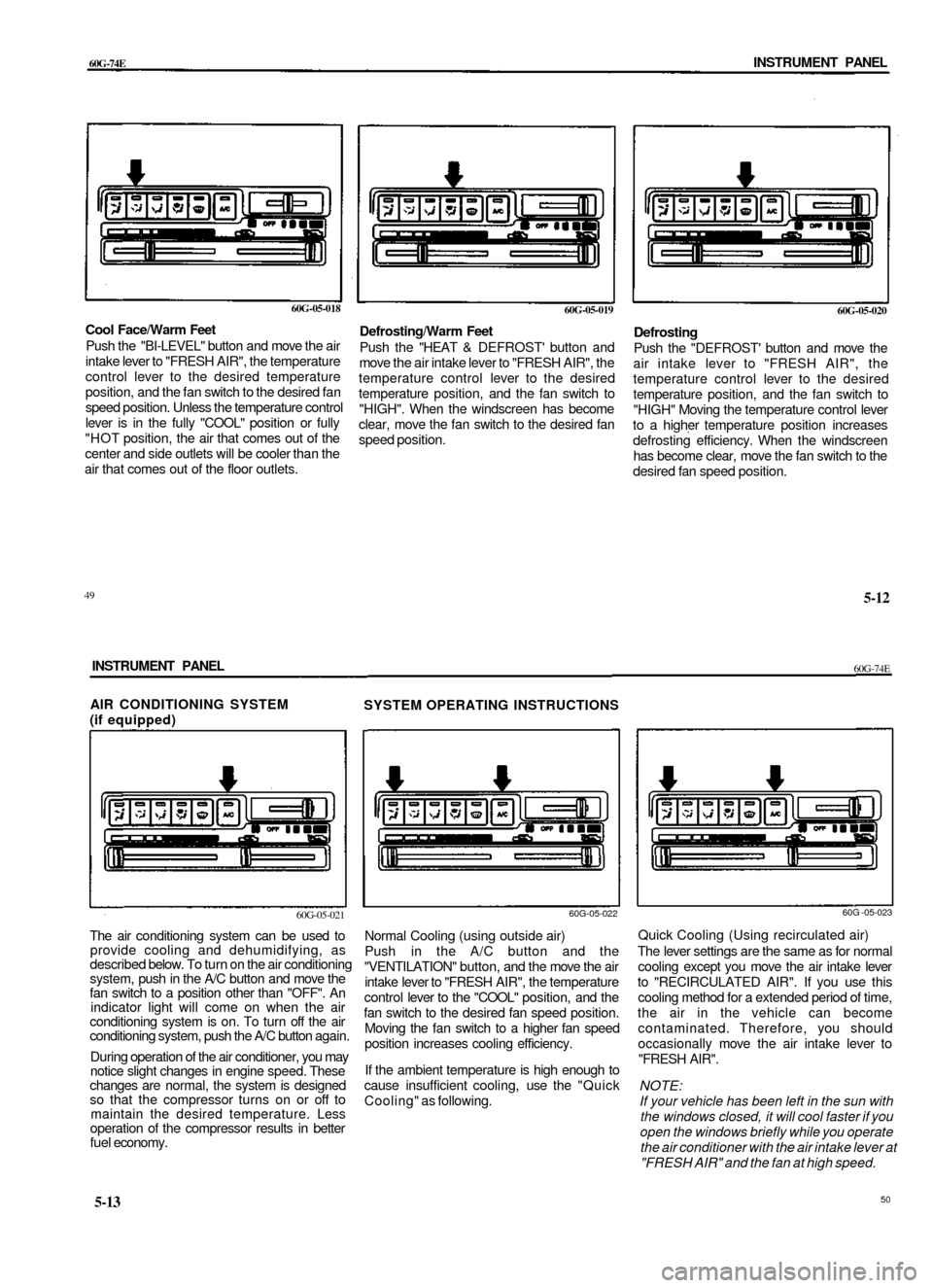
60G-74E
INSTRUMENT PANEL
60G-05-018
Cool Face/Warm Feet
Push the "BI-LEVEL" button and move the air
intake lever to "FRESH AIR", the temperature
control lever to the desired temperature
position, and the fan switch to the desired fan
speed position. Unless the temperature control
lever is in the fully "COOL" position or fully
"HOT position, the air that comes out of the
center and side outlets will be cooler than the
air that comes out of the floor outlets.
60G-05-019
Defrosting/Warm Feet
Push the "HEAT & DEFROST' button and
move the air intake lever to "FRESH AIR", the
temperature control lever to the desired
temperature position, and the fan switch to
"HIGH". When the windscreen has become
clear, move the fan switch to the desired fan
speed position.
60G-05-020
Defrosting
Push the "DEFROST' button and move the
air intake lever to "FRESH AIR", the
temperature control lever to the desired
temperature position, and the fan switch to
"HIGH" Moving the temperature control lever
to a higher temperature position increases
defrosting efficiency. When the windscreen
has become clear, move the fan switch to the
desired fan speed position.
49
5-12
INSTRUMENT PANEL
60G-74E
AIR CONDITIONING SYSTEM
(if equipped)
SYSTEM OPERATING INSTRUCTIONS
60G-05-021
The air conditioning system can be used to
provide cooling and dehumidifying, as
described below. To turn on the air conditioning
system, push in the A/C button and move the
fan switch to a position other than "OFF". An
indicator light will come on when the air
conditioning system is on. To turn off the air
conditioning system, push the A/C button again.
During operation of the air conditioner, you may
notice slight changes in engine speed. These
changes are normal, the system is designed
so that the compressor turns on or off to
maintain the desired temperature. Less
operation of the compressor results in better
fuel economy.
60G-05-022
Normal Cooling (using outside air)
Push in the A/C button and the
"VENTILATION" button, and the move the air
intake lever to "FRESH AIR", the temperature
control lever to the "COOL" position, and the
fan switch to the desired fan speed position.
Moving the fan switch to a higher fan speed
position increases cooling efficiency.
If the ambient temperature is high enough to
cause insufficient cooling, use the "Quick
Cooling" as following.
60G -05-023
Quick Cooling (Using recirculated air)
The lever settings are the same as for normal
cooling except you move the air intake lever
to "RECIRCULATED AIR". If you use this
cooling method for a extended period of time,
the air in the vehicle can become
contaminated. Therefore, you should
occasionally move the air intake lever to
"FRESH AIR".
NOTE:
If your vehicle has been left in the sun with
the windows closed, it will cool faster if you
open the windows briefly while you operate
the air conditioner with the air intake lever at
"FRESH AIR" and the fan at high speed.
5-13
50
Page 27 of 65

OTHER CONTROLS AND EQUIPMENTS
60G-74E
PARKING BRAKE LEVER
63B-06-001E
The parking brake lever is located between
the seats. To apply the parking brake, hold the
brake pedal down and pull the parking brake
lever all the way up.
63B-06-002E
To release the parking brake, hold the brake
pedal down, pull up slightly on the parking
brake lever, push the button on the end of the
lever with your thumb, and lower the lever to
its original position.
Never drive your vehicle with the
parking brake on: rear brake
effectiveness can be reduced from
over heating, brake life may be
shortened, or permanent brake
damage may result.
If the parking brake does not hold
the vehicle securely or does not fully
release, have your vehicle inspected
immediately by an authorized
MARUTI dealer.
Always apply the parking brake fully
before leaving your vehicle or it may
move, causing injury or damage. When
parking, make sure the gear shift lever
is left in first gear or reverse.
Remember, even though the
transmission is in gear, you must
always apply the parking brake fully.
6-1
54
60G-74E
OTHER CONTROLS AND EQUIPMENT
PEDALS
GEAR LEVER
60G-06-001
Clutch Pedal ©
The clutch pedal is used to disengage the drive
to the wheels when starting the engine,
stopping, or shifting the transmission lever.
Depressing the pedal disengages the clutch.
CAUTION
Do not drive with your foot resting on
the clutch pedal. It could result in
excessive clutch wear, clutch damage,
or unexpected loss of engine braking.
Brake Pedal ®
Your MARUTI vehicle is equipped with front
disc brakes and rear drum brakes. Depressing
the brake pedal applies both sets of brakes.
You may hear occasional brake squeal when
you apply the brakes. This is a normal
condition caused by environmental factors
such as cold, wet, snow, etc.
If brake squeal is excessive and occurs
each time the brakes are applied, you
should have the brakes checked by
your MARUTI dealer.
A WARNING
Do not "ride" the brakes by applying
them continuously or resting your foot
on the pedal. This will result in
overheating of the brakes which could
cause unpredictable braking action,
longer stopping distances, or
permanent brake damage.
Accelerator Pedal ®
This pedal controls the speed of the engine.
Depressing the accelerator pedal increases
power output and speed.
70F-04-005E
The gear change pattern is shown in the
illustration. For details on how to use the
transmission, refer to USING THE
TRANSMISSION in the OPERATING YOUR
VEHICLE section.
55
6-2
Page 32 of 65

S0G-74E
OPERATING YOUR VEHICLE
OPERATING YOUR VEHICLE
Exhaust Gas Warning 7-1
Daily Inspection Checklist 7-1
Starting the Engine 7-2
Using the Transmission 7-3
Braking 7-4
Running-in 7-5
Catalytic Converter (if equipped) 7-6
Improving Fuel Economy 7-7
Trailer Towing 7-7
OPERATING YOUR VECHILE
60G-74E
EXHAUST GAS WARNING
DAILY INSPECTION CHECKLIST
60G-07-001E
Avoid breathing exhaust gases.
Exhaust gases contain carbon
monoxide, a potentially lethal gas that
is colourless and odourless. Since
carbon monoxide is difficult to detect
by itself, be sure to take the following
precautions to help prevent carbon
monoxide from entering your vehicle.
• Do not leave the engine running in
garages or other confined areas.
• Do not park with the engine running
for a long period of time, even in an
open area. If it is necessary to sit for
a short time in a parked vehicle <=>
with the engine running, make sure
the air intake lever is set to "FRESH
AIR" and the fan is at high speed.
To allow proper operation of your
vehicle's ventilation system, keep
the air inlet grille in front of the
windscreen clear of snow, leaves, or
other obstructions at all times.
Keep the exhaust tailpipe area clear
of snow and other material to help
reduce the buildup of exhaust gases
under the vehicle.This is particularly
important when parked in blizzard
conditions.
Have the exhaust system inspected
periodically for damage and leaks.
Any damage or leaks should be
repaired immediately.
7-1
70F-05-007
Before driving:
1) Make sure that windows, mirrors, lights,
and reflectors are clean and unobstructed.
2) Check the tyres.
3) Look for fluid and oil leaks.
NOTE:
It is normal for water to drip from the air
conditioning system after use.
4) Adjust the seat/head restraint.
5) Check the brake pedal and the parking
brake lever.
6) Adjust the mirrors.
7) Make sure that you and passengers have
properly fastened your seat belts.
8) Make sure that all warning lights come on
as the key is turned to the "ON" or "START'
position.
9) Check all gauges.
10) Make sure that the brake fluid level
warning light is off when the parking brake
is released with the ignition switch in "ON"
position.
66
65
Page 33 of 65
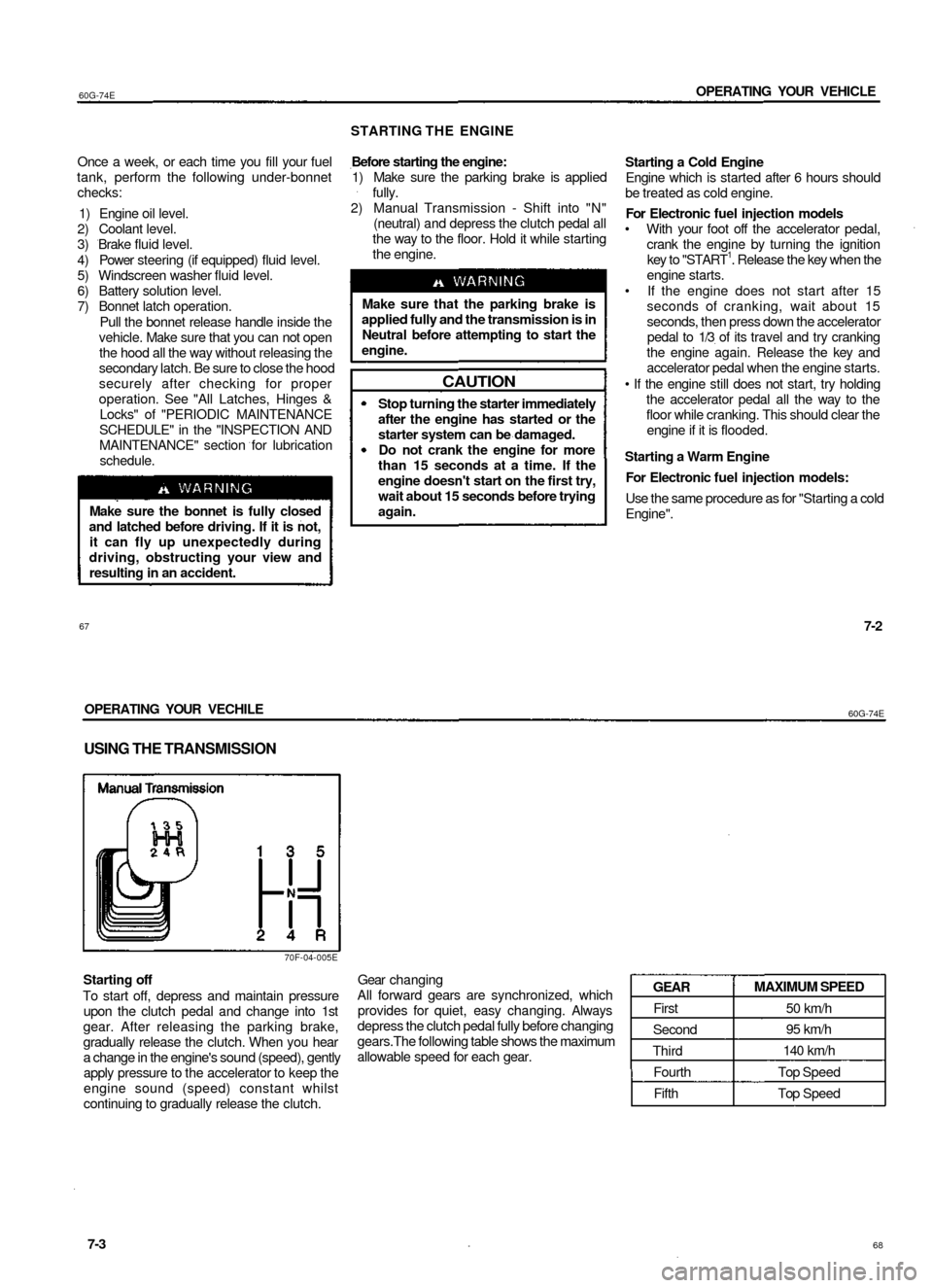
60G-74E
OPERATING YOUR VEHICLE
Once a week, or each time you fill your fuel
tank, perform the following under-bonnet
checks:
1) Engine oil level.
2) Coolant level.
3) Brake fluid level.
4) Power steering (if equipped) fluid level.
5) Windscreen washer fluid level.
6) Battery solution level.
7) Bonnet latch operation.
Pull the bonnet release handle inside the
vehicle. Make sure that you can not open
the hood all the way without releasing the
secondary latch. Be sure to close the hood
securely after checking for proper
operation. See "All Latches, Hinges &
Locks" of "PERIODIC MAINTENANCE
SCHEDULE" in the "INSPECTION AND
MAINTENANCE" section for lubrication
schedule.
Make sure the bonnet is fully closed
and latched before driving. If it is not,
it can fly up unexpectedly during
driving, obstructing your view and
resulting in an accident.
STARTING THE ENGINE
Before starting the engine:
1) Make sure the parking brake is applied
fully.
2) Manual Transmission - Shift into "N"
(neutral) and depress the clutch pedal all
the way to the floor. Hold it while starting
the engine.
Make sure that the parking brake is
applied fully and the transmission is in
Neutral before attempting to start the
engine.
CAUTION
Stop turning the starter immediately
after the engine has started or the
starter system can be damaged.
Do not crank the engine for more
than 15 seconds at a time. If the
engine doesn't start on the first try,
wait about 15 seconds before trying
again.
Starting a Cold Engine
Engine which is started after 6 hours should
be treated as cold engine.
For Electronic fuel injection models
• With your foot off the accelerator pedal,
crank the engine by turning the ignition
key to "START1. Release the key when the
engine starts.
• If the engine does not start after 15
seconds of cranking, wait about 15
seconds, then press down the accelerator
pedal to 1/3 of its travel and try cranking
the engine again. Release the key and
accelerator pedal when the engine starts.
• If the engine still does not start, try holding
the accelerator pedal all the way to the
floor while cranking. This should clear the
engine if it is flooded.
Starting a Warm Engine
For Electronic fuel injection models:
Use the same procedure as for "Starting a cold
Engine".
67
7-2
OPERATING YOUR VECHILE
60G-74E
USING THE TRANSMISSION
70F-04-005E
Starting off
To start off, depress and maintain pressure
upon the clutch pedal and change into 1st
gear. After releasing the parking brake,
gradually release the clutch. When you hear
a change in the engine's sound (speed), gently
apply pressure to the accelerator to keep the
engine sound (speed) constant whilst
continuing to gradually release the clutch.
Gear changing
All forward gears are synchronized, which
provides for quiet, easy changing. Always
depress the clutch pedal fully before changing
gears.The following table shows the maximum
allowable speed for each gear.
GEAR
First
Second
Third
Fourth
Fifth
MAXIMUM SPEED
50 km/h
95 km/h
140 km/h
Top Speed
Top Speed
7-3
68